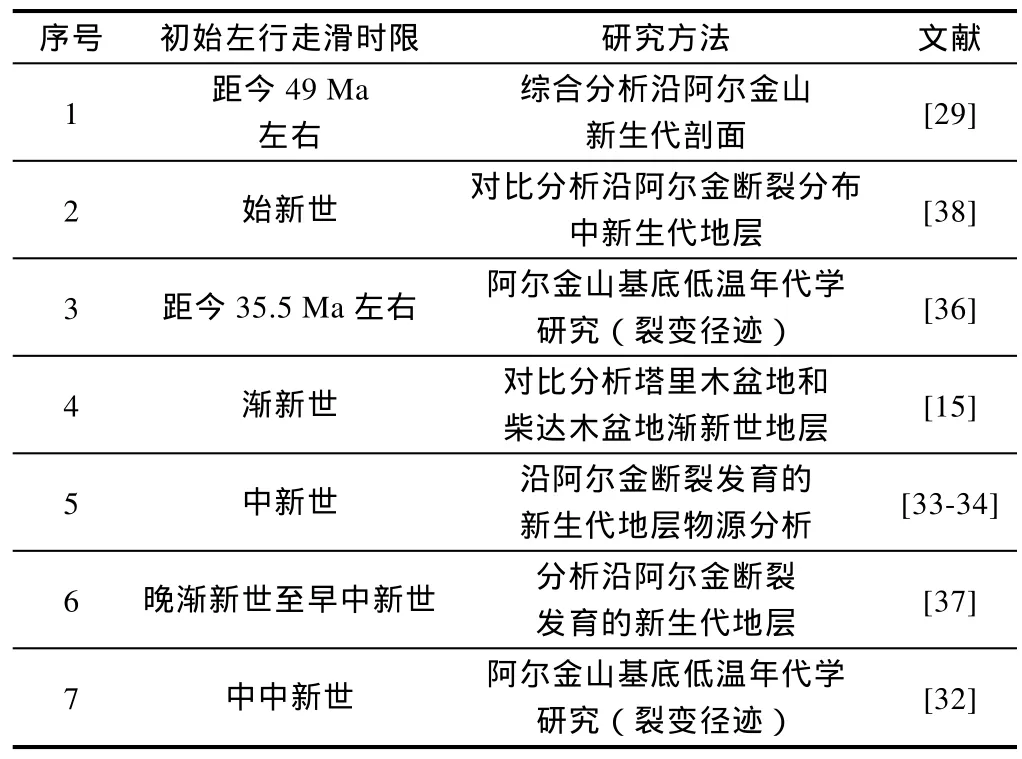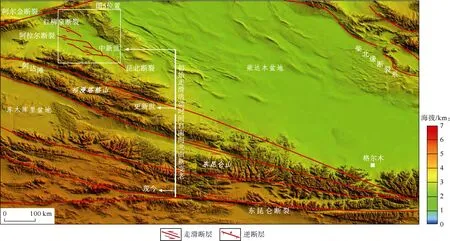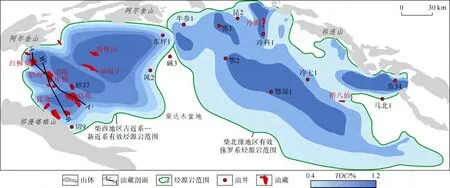柴达木走滑叠合盆地及其控油气作用
2015-01-15付锁堂马达德郭召杰程丰
付锁堂,马达德,郭召杰,程丰
(1. 中国石油青海油田公司;2. 造山带与地壳演化教育部重点实验室,北京大学地球与空间科学学院)
0 引言
柴达木盆地位于青藏高原北缘,地貌上呈三角形,夹持于阿尔金山、东昆仑山以及祁连山三大山系之间。柴达木盆地是青藏高原内部最大的含油气盆地,自2007年柴达木盆地西南部切6井获得高产工业油流开始,近几年在切克里克、英东、东坪、英西等地区相继发现了大型油气田,开创了高原盆地油气勘探的新局面。柴达木盆地具有独特的构造背景和属性,也具有独特的油气成藏过程和成藏规律。柴达木盆地的特殊性可以概括为几个唯一性:①全球唯一以两条大型走滑断裂带(阿尔金走滑断裂带和东昆仑走滑断裂带)为边界夹持的盆地;②唯一位于青藏高原内部的大型含油气盆地;③中国西部唯一以中新生界陆相油气藏为主的大型含油气盆地。由此可见,柴达木盆地具有上述不同于其他盆地的特征和油气勘探实践,理应具有独特的盆地构造和成藏理论。
1 认识的异同与关键
长期以来,对于柴达木盆地成因及属性的认识存在较大分歧。早期石油地质工作者认为柴达木盆地中、新生代存在 3个构造演化阶段,即侏罗纪至白垩纪断陷盆地阶段、古近纪坳陷盆地阶段以及新近纪反转盆地阶段[1]。随着勘探的深入,有学者提出了柴达木盆地白垩纪至古近纪伸展—新近纪挤压两阶段盆地演化模型[2]。近年来,陆续有学者提出柴达木盆地属于叠合盆地这一认识,即新近纪以来的类前陆盆地叠加于侏罗纪至古近纪褶皱基底拉分盆地之上[3-4]。另外,也有学者根据最新的油气勘探资料将柴达木盆地成盆演化史分为 4个阶段:侏罗纪断陷、白垩纪挤压、古近纪稳定广盆/挤压走滑、新近纪挤压陆内拗陷[5]。上述对于柴达木盆地构造演化与属性的不同认识,归咎于对柴达木盆地与周缘造山带的盆山关系认识的分歧(见图1)。早期研究多认为柴达木盆地成因与东昆仑山向北逆冲推覆有关[6-9],即柴达木盆地是东昆仑山的前陆盆地,并沿着柴达木盆地南部发育的一系列南倾断层或者转换挤压系统持续向北逆冲[10-11]。然而基于盆地内部地震剖面资料,Yin等[12]则提出截然相反的观点,认为柴达木盆地之下发育一套大型向南逆冲的楔形构造,该楔形构造始于祁连山山前,将柴达木盆地向南逆冲推覆到东昆仑造山带之上,即柴达木盆地是祁连山的前陆盆地,同时也是东昆仑山的背驮式盆地[12-14]。另外,通过对比塔里木盆地西南缘和柴达木盆地西部地区地层,亦有部分学者认为柴达木盆地在渐新世之前属于塔里木盆地的一部分,阿尔金断裂自渐新世开始的左行走滑运动才造成柴达木盆地与塔里木盆地的分离,使得柴达木盆地逐渐发展为一个大型的山间挤压盆地,并进一步指出青藏高原北部上地壳发生纵弯褶皱是柴达木盆地形成的主要原因[15-16]。

图1 柴达木盆地及周缘地区地形地貌及主干断裂分布图(地形数据采用90 m分辨率的SRTM数据[17])
尽管对于柴达木盆地成因与属性的认识还存在较大分歧,但随着近几年柴达木盆地地震勘探攻关的不断展开,许多基本地质特征逐步被揭示。基于磁性地层学、古植物学、孢粉学以及地震勘探上取得的巨大突破,全盆地范围内新生代地层层序和时代得以建立并准确约束,自下而上可划分为8套岩石地层单元[18-24]:路乐河组、下干柴沟组下段、下干柴沟组上段、上干柴沟组、下油砂山组、上油砂山组、狮子沟组和七个泉组(见图 2)。全盆地新生代地层展布规律则反映自路乐河组沉积以来,柴达木盆地沉积中心始终位于盆地轴部中心,并自西向东逐渐迁移[20-22]。

图2 柴达木盆地西部新生代综合地层柱状图
与此同时,由于受到阿尔金断裂左行走滑运动的控制,柴达木盆地作为一个刚性块体整体新生代向东北发生大规模迁移[25-26]。丰富的高精度二维、三维地震剖面则揭示了柴北缘地区地壳变形发生于始新世,而柴达木西部阿尔金山前、东昆仑山山前则发育中新世生长地层,指示东昆仑山地壳变形发生于中新世[12-13]。另外,油气勘探发现柴西地区古近系—新近系发育一套细粒咸化湖相沉积,特别是以下干柴沟组上段和上干柴沟组为主的优质烃源岩(见图2),而柴北缘地区的古近系则表现为一套类前陆盆地粗碎屑沉积,古近系烃源岩不发育[27]。上述地质特征与勘探研究成果为进一步研究柴达木盆地提供了良好的研究基础。由此可见,明确柴达木盆地与周缘造山带的盆山构造关系是揭示柴达木盆地新生代演化史,阐明柴达木盆地成因与属性、确立柴达木盆地油气成藏理论的关键。
2 柴达木盆地周缘构造特征
2.1 阿尔金左行走滑断裂—柴北缘逆冲断裂系统
阿尔金断裂带是青藏高原边缘一条大型左行走滑断裂,它限定了柴达木盆地西部边界(见图 1)。阿尔金左行走滑断裂新生代的活动控制着柴达木盆地新生代的演化,探究阿尔金断裂新生代的活动规律以及构造演化历史,对于认识柴达木盆地新生代演化史具有重大意义[28-31]。对于阿尔金断走滑裂新生代构造活动的研究,需要明确两个关键问题,即阿尔金断裂新生代初始左行走滑运动时限和新生代左行走滑位移量。对于阿尔金断裂自印度—欧亚板块碰撞以来的开始活动时间尚存在一定争议,但多认为是从始新世到中新世[29,32-38](见表 1)。对于阿尔金断裂新生代左行走滑位移量的评估,尽管前人所选择的对比参考点不同(如缝合带、岩浆岩体或侏罗系煤线作为错断标志),但一般认为阿尔金断裂的左行走滑位移量为 300~400 km[15,38-48]。最新的古地磁研究表明,柴达木盆地新生代自始新世开始沿着阿尔金断裂向北东方向不断迁移,运移过程中柴达木盆地整体未发生大规模垂向旋转[26]。基于上述认识,Cheng等[38]通过系统对比柴达木盆地与吐拉盆地中新生代地层沉积特征,识别出与阿尔金断裂新生代左行走滑相关的同构造沉积,进而指出阿尔金断裂左行走滑活动开始于路乐河组沉积时期,并在中新世后速度加快,即始新世为阿尔金断裂初始活动时限,阿尔金走滑断裂左行走滑量约为360 km。
柴北缘—祁连山南山作为柴达木盆地的东北部边界,发育一系列北西西走向逆冲断裂系,如柴北缘逆冲断裂系、党河—南山断裂系等(见图1、图3)。其中,柴北缘逆冲断裂系平面上呈北西西—南东东向展布。这些断裂构造在剖面上断面呈北倾,多表现为由祁连山向盆地方向逆冲,部分断裂存在走滑分量[14,49-50]。据柴北缘地区地震剖面资料显示,这些断裂的逆冲推覆于始新世开始活动并持续至今[13-14]。结合野外地层沉积记录,一般认为,自印度—欧亚板块碰撞以来柴北缘—祁连山地区地壳变形开始于始新世路乐河组沉积期[14,51],并伴随 20%~50%的北东—南西向地壳缩短[13-14,52-53]。基于全盆地范围新生代地层的磁组构研究,Yu等[54]发现柴北缘地区自古近纪开始受由北向南挤压应力,柴西南地区则处于松弛状态、挤压应力不明显,而自新近纪开始柴北缘地区遭受北东—南西向挤压应力,柴西地区亦出现北东—南西向挤压应力(见图 3)。柴北缘断裂系自路乐河期以来的逆冲兼走滑活动改造了柴北缘中生代地层展布格局,同时形成的扭压断层及相关褶皱圈闭为侏罗系油气成藏提供了有效圈闭条件[50]。

表1 阿尔金断裂初始走滑时限前人研究总结

图3 柴达木盆地周缘地区主干断裂分布及古近纪、新近纪主应力方位图
笔者认为阿尔金左行走滑与柴北缘逆冲断裂活动时限可能开始于始新世。换而言之,阿尔金左行走滑断裂与柴北缘断裂系处于同一构造系统:开始于古新世—始新世的阿尔金左行走滑导致了柴北缘始新世的北西向逆冲断裂的活动,同时柴达木盆地整体开始大规模沉降。结合大约360 km的阿尔金左行走滑位移量评估,具有相对刚性基底的柴达木盆地自始新世开始整体沿阿尔金断裂向东北方向迁移360 km,该位移量通过柴北缘—祁连山地区地壳的北东—南西向缩短与向东南向挤出得以调节。由此可见,自始新世以来阿尔金走滑断裂为柴达木盆地重要的控制边界,柴北缘—祁连山逆冲褶皱断裂带为柴达木盆地被动适应边界。
2.2 东昆仑断裂中新世以来左行走滑及对盆地的叠合调节作用
东昆仑左行走滑断裂位于柴达木盆地的南缘,平面上呈近东西向展布,途经昆仑山口,向西延伸,并在西段祁漫塔格地区形成一系列由线性断裂组成的弓形构造[56-59](见图1、图4)。东昆仑基底裂变径迹和40Ar/39Ar低温年代学研究表明,东昆仑山体在渐新世至早中新世发生过数次快速冷却事件,推测可能与同期东昆仑山大规模构造活动相关[10-11]。Cheng等[58]和 Duvall等[55]通过对东昆仑地区基底裂变径迹和(U-Th)/He低温年代学研究,认为东昆仑左行走滑断裂可能开始于渐新世至中新世。Yin等[12]则根据识别出的东昆仑山前、柴达木盆地南缘新生代生长地层,认为东昆仑断裂活动始于渐新世。

图4 柴西南地区东昆仑西段走滑断裂向北迁移模型图(地形数据采用90 m分辨率的SRTM数据[17])
对于东昆仑山与柴达木盆地的构造关系尚且存在不同认识[6-13]。早期研究主要认为东昆仑地区发育大型的转换挤压系统,其南部边界为东昆仑左行走滑断裂,北部则发育一系列南倾的断裂并控制了柴达木盆地西南缘地区的新生代演化[6-8,10-11]。但由于该模型无法合理解释柴达木盆地沉积中心并未靠近东昆仑山前的地层分布特征,Yin等[13]则提出了与上述截然相反的观点,即柴达木盆地南缘发育一套大型的楔形构造,该楔形构造将柴达木盆地向南逆冲推覆到东昆仑造山带之上,低海拔的柴达木盆地可能沿着一系列向北倾的新生代断裂向南逆冲到相对高海拔的祁漫塔格山之上。该观点得到一些地壳深部地球物理资料的支持[60-61]。虽然向南逆冲的模型合理解释了柴达木盆地新生代地层碟形分布特征,但该模型无法合理解释平面上东昆仑西段祁漫塔格山地区向北突起的弧形构造的成因[57]。
最新天然地震震源分布、震源机制研究表明柴西南地区和祁漫塔格山地区现今构造属性表现为逆冲兼左行走滑特征[58](见图 4)。遥感影像与野外地质调查表明祁漫塔格山地区存在更新世同走滑构造变形沉积记录[58]。另外,柴达木盆地西南部的构造和沉积格架主要表现为一系列高角度走滑断裂所分割而形成的隆坳格局,主要发育昆北断裂、阿拉尔断裂以及红柳泉断裂。其雁行状展布特征及被断裂错段的始新世地层展布规律指示了左行走滑特征(见图5)。柴西南地区地震剖面中生长地层指示该地区于中新世早期开始左行走滑运动(见图6)。平面上,东昆仑左行走滑断裂西段分支断裂的初始活动时间呈现出由南(现今东昆仑左行活动断裂)向北(柴西南昆北断裂带)逐渐变老的分布规律(见图4)。
基于上述分析,笔者认为东昆仑山与柴达木盆地之间既非向南逆冲,也非向北的简单逆冲推覆关系,而是以东昆仑左行走滑断裂为代表的走滑断裂边界。基于东昆仑山祁漫塔格地区左行走滑断裂活动初始时间在空间上自北向南不断变新的现象,认为东昆仑左行走滑断裂自早中新世活动以来,受阿尔金断裂左行走滑运动控制而不断向北迁移生长,迁移过程中左行走滑属性逐渐转变为向北逆冲兼左行走滑性质(见图7),即东昆仑左行走滑断裂是柴达木盆地新近纪以来的重要走滑调节边界。
3 柴达木走滑叠合盆地构造控藏作用
3.1 柴达木盆地烃源岩分布特征
勘探表明柴达木盆地发育侏罗系、古近系—新近系和第四系 3套重要的含油气系统[62-63]。其中,侏罗系主要发育于柴达木盆地北缘地区,烃源岩以中下侏罗统(J1+2)暗色煤系泥岩为主(见图8)。

图5 柴西南地区下干柴沟组上段地层厚度与断层分布图(据文献[58]修改)

图6 柴西南地区阿拉尔断裂构造剖面图(剖面位置见图5)

图7 柴西南地区走滑断裂向北迁移模型图(据文献[58]修改)

图8 柴达木盆地烃源岩有机碳含量与油气分布特征(据文献[27]修改)
柴达木盆地古近系—新近系有效烃源岩在柴北缘地区基本不发育,而主要发育于柴西地区,具有典型盐湖相烃源岩特征[27,63]。柴西地区烃源岩以有机质丰度低、转化率高为特征,生烃潜力较大,形成了柴西地区富油气凹陷(见图 8)。柴西地区古近系—新近系烃源岩发育层系多、分布广、厚度大,主要分布在茫崖凹陷内,包括路乐河组(E1+2)上部、下干柴沟组(E3)、上干柴沟组(N1)、下油砂山组(N21)、上油砂山组(N22)等。其中,以始新统下干柴沟组上段(E32)和渐新统上干柴沟组(N1)为主,以碳酸盐含量较高、有机质丰度偏低、类型中—差、烃转化率较高为特征,形成了构造、地层-岩性等多种类型油气藏[27]。前人通过对柴西地区的尕斯、乌南、红柳泉、切6、南翼山和油泉子等代表性油田构造的解剖,并结合区域地质综合分析,认为柴西地区油气成藏时间主要发生于喜马拉雅中晚期,主要表现为两个阶段(N21末期及N23—Q时期)[27]。根据前述的油气成藏特征及成藏时间,柴西地区的油气成藏与晚期构造活动关系紧密,油气成藏期次及时间与东昆仑走滑断裂带活动及其对盆地控制有良好的对应关系,主要表现为距今15~8 Ma(约为N21末期)的油气成藏和距今4 Ma以来的晚期成藏[27]。
柴西地区由于受祁漫塔格山走滑兼逆冲断裂系和阿尔金左旋走滑断裂系的联合制约,因而发育大量的北西—北西西向、北东向和近南北向断裂构造[57,64]。
柴西地区油气藏则常与断裂构造相伴生[65]。沿着阿拉尔、Ⅺ号等断裂分布有砂西—尕斯库勒等油气聚集带(见图 8、图 9),沿着英雄岭南缘的英西、油砂山、英东构造发现的大型油气藏均与新生代晚期断裂带关系密切;阿尔金山前带沿红柳泉等断裂则分布有断鼻构造控制的构造-地层-岩性复合型油气藏。另外,南翼山断裂、尖顶山断裂分布有油泉子、南翼山等构造-裂缝型油气藏(见图8、图9)。由此可见,柴达木盆地西部地区自新近纪开始发育的走滑相关构造断裂对柴西地区圈闭形成和油气成藏具有重要意义[64-65]。
3.2 走滑叠合盆地构造控藏作用
通过系统分析柴达木盆地与周缘造山带的构造关系,提出柴达木盆地是由东昆仑左行走滑断裂和阿尔金左行走滑断裂联合控制的走滑叠合盆地这一新的理论模型。

图9 柴西南地区典型油藏剖面(剖面位置见图8)

图10 柴达木盆地及周缘地区新生代构造-沉积演化示意图
自始新世(见图 10a),阿尔金断裂开始发生左行走滑,受其影响,相对刚性基底的柴达木盆地块体沿着阿尔金左行走滑断裂带逐渐向北东方向迁移,并导致柴北缘—祁连山地区于始新世开始发生北东—南西向地壳缩短,故而柴北缘地区表现为类似祁连山前陆盆地沉积区,古近纪沉积了一套粗碎屑地层,缺乏优质烃源岩。与此同时,柴西南地区则处于相对伸展应力背景之中,表现为扭张背景下的坳陷沉积区,因而沉积一套细粒沉积地层,并发育优质古近系烃源岩。
中新世以来(见图10b),东昆仑断裂系开始左行走滑运动,随着柴达木盆地的北东向迁移东昆仑左行断裂的西段逐渐自北向南迁移,并形成了一系列雁行排列的断裂(昆北断裂、阿拉尔断裂、祁漫塔格山断裂等)。这些走滑断裂系的形成并持续向北迁移以及东昆仑山与祁漫塔格山发生的快速隆升,导致柴西地区自中新世开始由古近纪时期相对的伸展背景转变为受北东—南西向应力挤压背景中,因此柴西地区新近系表现为自下而上逐渐变粗的碎屑沉积。形成于中新世的走滑相关构造(昆北断裂、Ⅺ号断裂、阿拉尔断裂、红柳泉断裂、英雄岭构造等)是柴西南地区以古近系烃源岩为主的油气聚集和新生代晚期成藏的重要场所,沿断裂带发育的裂缝系统,是改善储集层物性的重要控藏因素之一。
阿尔金走滑断裂为柴达木盆地重要的控制边界,自始新世活动以来控制了新生代不同时期不同沉积中心发育和迁移规律;柴北缘—祁连山逆冲褶皱断裂带为柴达木盆地被动调节边界,自始新世以来持续北东—南西向挤压变形;东昆仑左行走滑断裂则为柴达木盆地主动叠合调节边界,自中新世以来的左行走滑及迁移活动,奠定了柴西地区的构造样式,成为重要的油气聚集控制要素。上述阿尔金断裂和东昆仑断裂两条大型左行走滑断裂及柴北缘—祁连山逆冲褶皱带在时间与空间上的叠合,演绎了柴达木盆地新生代以来独特的走滑叠合盆地构造特征,并控制了柴达木盆地新生代以来的油气聚集与成藏规律。
4 结论
确定柴达木盆地与周缘造山带的盆山构造关系是揭示柴达木盆地新生代演化史以及探究柴达木油气成藏理论的基础与关键。
柴达木盆地是一个具有高原特色的叠合盆地,其“叠合性”具体表现在时间与空间两方面:古近纪,柴达木盆地主要受控于阿尔金左行走滑断裂,可将柴达木盆地视为受阿尔金左行走滑断裂带控制的柴北缘扭压、柴西南扭张的简单走滑相关盆地;而自新近纪以来,阿尔金断裂持续左行走滑活动,与此同时,东昆仑断裂开始发生左行走滑及南北迁移活动,柴达木盆地同时受到阿尔金与东昆仑两大左行走滑断裂联合控制,故可将柴达木盆地视为受阿尔金与东昆仑左行走滑断裂联合控制的走滑叠合盆地。这两条大型左行走滑断裂及柴北缘—祁连山逆冲褶皱带在时间与空间上的叠合,演绎了柴达木盆地新生代以来独特走滑叠合盆地构造特征,控制了柴达木盆地新生代以来的油气聚集与成藏。
近年来,随着思维创新及技术进步,陆续在切克里克、英东、东坪、牛东、英西等地区取得了油气勘探的重大突破,展现了柴达木盆地是一个具有巨大勘探前景的高原盆地。柴达木“走滑叠合盆地”新概念的逐步成熟和具有走滑叠合盆地特色的油气成藏理论的不断完善,将为开创柴达木盆地油气勘探的新局面、加快建成千万吨级高原油气田提供扎实的理论支撑。
[1] 青藏油气区石油地质志编写组. 中国石油地质志: 卷十四[M]. 北京: 石油工业出版社, 1990: 331-482.Compiling Group of Petroleum Geology in Tibet Oil and Gas Area.Petroleum geology of China: Vol. 14[M]. Beijing: Petroleum Industry Press, 1990: 331-482.
[2] Xia Wenchen, Zhang Ning, Yuan Xiaoping, et al. Cenozoic Qaidam Basin, China: A stronger tectonic inversed, extensional rifted basin[J]. AAPG Bulletin, 2001, 85(4): 715-736.
[3] 赵文智, 张光亚, 王红军, 等. 中国叠合含油气盆地石油地质基本特征与研究方法[J]. 石油勘探与开发, 2003, 30(2): 1-8.Zhao Wenzhi, Zhang Guangya, Wang Hongjun, et al. Basic features of petroleum geology in the superimposed petroliferous basins of China and their research methodologies[J]. Petroleum Exploration and Development, 2003, 30(2): 1-8.
[4] 何登发, 贾承造, 童晓光, 等. 叠合盆地概念辨析[J]. 石油勘探与开发, 2004, 31(1): 1-7.He Dengfa, Jia Chengzao, Tong Xiaoguang, et al. Discussion and analysis of superimposed sedimentary basins[J]. Petroleum Exploration and Development, 2004, 31(1): 1-7.
[5] 金之钧, 张明利, 汤良杰, 等. 柴达木中新生代盆地演化及其控油气作用[J]. 石油与天然气地质, 2004, 25(6): 603-608.Jin Zhijun, Zhang Mingli, Tang Liangjie, et al. Evolution of Meso-Cenozoic Qaidam Basin and its control on oil and gas[J]. Oil& Gas Geology, 2004, 25(6): 603-608.
[6] Burchfiel B C, Deng Q D, Molnar P, et al. Intracrustal detachment within zones of continental deformation[J]. Geology, 1989, 17(8):748-752.
[7] Meyer B, Tapponnier P, Bourjot L, et al. Crustal thickening in Gansu-Qinghai, lithospheric mantle subduction, and oblique,strike-slip controlled growth of the Tibet Plateau[J]. Geophysical Journal International, 1998, 135(1): 1-47.
[8] Tapponnier P, Xu Z Q, Roger F, et al. Oblique stepwise rise and growth of the Tibet Plateau[J]. Science, 2001, 294: 1671-1677.
[9] Chen W P, Chen C Y, Nábelek J L. Present-day deformation of the Qaidam Basin with implications for intra-continental tectonics[J].Tectonophysics, 1999, 305(1/2/3): 165-181.
[10] Mock C, Arnaud N O, Cantagrel J M. An early unroofing in northeastern Tibet constraints from40Ar/39Ar thermochronology on granitoids from the eastern Kunlun range (Qianghai, NW China)[J].Earth and Planetary Science Letters, 1999, 171(1): 107-122.
[11] Jolivet M, Brunel M, Seward D, et al. Mesozoic and Cenozoic tectonics of the northern edge of the Tibetan Plateau: Fission-track constraints[J]. Tectonophysics, 2001, 343(1/2): 111-134.
[12] Yin A, Dang Y Q, Zhang M, et al. Cenozoic tectonic evolution of Qaidam Basin and its surrounding regions (part 2): Wedge tectonics in southern Qaidam Basin and the Eastern Kunlun range[J].Geological Society of America, Special Papers, 2007, 433: 369-390.
[13] Yin A, Dang Y Q, Zhang M, et al. Cenozoic tectonic evolution of the Qaidam Basin and its surrounding regions (Part 3): Structural geology, sedimentation, and regional tectonic reconstruction[J].Geological Society of America Bulletin, 2008, 120(7/8): 847-876.
[14] Yin A, Dang Y Q, Wang L C, et al. Cenozoic tectonic evolution of Qaidam Basin and its surrounding regions (Part 1): The southern Qilian Shan-Nan Shan thrust belt and northern Qaidam Basin[J].Geological Society of America Bulletin, 2008, 120(7/8): 813-846.
[15] Meng Q R, Hu J M, Yang F Z. Timing and magnitude of displacement on the Altyn Tagh fault: Constraints from stratigraphic correlation of adjoining Tarim and Qaidam Basins, NW China[J].Terra Nova, 2001, 13(2): 86-91.
[16] Meng Q R, Fang X. Cenozoic tectonic development of the Qaidam Basin in the northeastern Tibetan Plateau[J]. Geological Society of America, Special Papers, 2008, 444: 1-24.
[17] CGIAR. SRTM 90m digital elevation data[EB/OL]. (2008-08-19)[2015-05-20]. http://srtm.csi.cgiar.org.
[18] Fang Xiaoming, Zhang Weilin, Meng Qingquan, et al.High-resolution magnetostratigraphy of the Neogene Huaitoutala section in the eastern Qaidam Basin on the NE Tibetan Plateau,Qinghai Province, China and its implication on tectonic uplift of the NE Tibetan Plateau[J]. Earth and Planetary Science Letters, 2007,258(1/2): 293-306.
[19] Lu Haijian, Xiong Shangfa. Magnetostratigraphy of the Dahonggou Section, northern Qaidam Basin and its bearing on Cenozoic tectonic evolution of the Qilian Shan and Altyn Tagh fault[J]. Earth and Planetary Science Letters, 2009, 288(3): 539-550.
[20] 黄汉纯, 黄清华, 马永生. 柴达木盆地地质与油气预测[M]. 北京:地质出版社, 1996.Huang Hanchun, Huang Qinghua, Ma Yongsheng. Geology of Qaidam Basin and its petroleum prediction[M]. Beijing: Geological Publishing House, 1996.
[21] 杨藩, 马志强, 许同春, 等. 柴达木盆地第三纪磁性地层柱[J]. 石油学报, 1992, 13(2): 97-101.Yang Fan, Ma Zhiqiang, Xu Tongchun, et al. A Tertiary paleomagnetic stratigraphic profile in Qaidam Basin[J]. Acta Petrolei Sinica, 1992, 13(2): 97-101.
[22] Sun Jimin, Zhu Rixiang, An Zhishen. Tectonic uplift in the northern Tibetan Plateau since 13.7 Ma ago inferred from molasse deposits along the Altyn Tagh fault[J]. Earth and Planetary Science Letters,2005, 235(3): 641-653.
[23] Ke Xue, Ji Junliang, Zhang Kexin, et al. Magnetostratigraphy and anisotropy of magnetic susceptibility of the Lulehe Formation in the Northeastern Qaidam Basin[J]. Acta Geologica Sinica: English Edition, 2013, 87(2): 576-587.
[24] Rieser A B, Liu Yongjiang, Genser J, et al.40Ar/39Ar ages of detrital white mica constrain the Cenozoic development of the intracontinental Qaidam Basin, China[J]. GSA Bulletin, 2006,118(11/12): 1522-1534.
[25] Yu Xiangjiang, Fu Suotang, Guan Shuwei, et al. Paleomagnetism of Eocene and Miocene sediments from the Qaidam Basin: Implication for no integral rotation since the Eocene and a rigid Qaidam Block[J].Geochemistry, Geophysics, Geosystems, 2014, 15(6): 2109-2127.
[26] Wang Erchie, Xu Fengyin, Zhou Jianxun, et al. Eastward migration of the Qaidam Basin and its implications for Cenozoic evolution of the Altyn Tagh fault and associated river systems[J]. Geological Society of America Bulletin, 2006, 118(3/4): 349-365.
[27] 付锁堂. 柴达木盆地西部油气成藏主控因素与有利勘探方向[J].沉积学报, 2010, 28(2): 373-379.Fu Suotang. Key controlling factors of oil and gas accumulation in the western Qaidam Basin and its implications for favorable exploration direction[J]. Acta Sedimentologica Sinica, 2010, 28(2):373-379.
[28] Molnar P, Tapponnier P. Cenozoic tectonics of Asia: Effects of a continental collision[J]. Science, 1975, 189: 419-426.
[29] Yin An, Rumelhart P, Butler R, et al. Tectonic history of the Altyn Tagh fault system in northern Tibet inferred from Cenozoic sedimentation[J]. Geological Society of America Bulletin, 2002,114(10): 1257-1295.
[30] Robinson D M, Dupont-Nivet G, Gehrels G E, et al. The Tula uplift,northwestern China: Evidence for regional tectonism of the northern Tibetan Plateau during late Mesozoic–early Cenozoic time[J].Geological Society of America Bulletin, 2003, 115(1): 35-47.
[31] Peltzer G, Tapponnier P. Formation and evolution of strike-slip faults, rifts, and basins during the India-Asia collision: An experimental approach[J]. Journal of Geophysical Research: Solid Earth(1978-2012), 1988, 93(B12): 15085-15117.
[32] 万景林, 王瑜, 李齐, 等. 阿尔金山北段晚新生代山体抬升的裂变径迹证据[J]. 矿物岩石地球化学通报, 2001, 20(4): 222-224.Wan Jinglin, Wang Yu, Li Qi, et al. FT evidence of northern Altyn uplift in Late-Cenozoic[J]. Bulletin of Mineralogy, Petrology and Geochemistry, 2001, 20(4): 222-224.
[33] Wu Lei, Xiao Ancheng, Yang Shufeng, et al. Two-stage evolution of the Altyn Tagh fault during the Cenozoic: New insight from provenance analysis of a geological section in NW Qaidam Basin,NW China[J]. Terra Nova, 2012, 24(5): 387-395.
[34] Wu Lei, Xiao Ancheng, Wang Liang, et al. EW-trending uplifts along the southern side of the central segment of the Altyn Tagh fault,NW China: Insight into the rising mechanism of the Altyn Mountain during the Cenozoic[J]. SCIENCE CHINA Earth Sciences, 2012,55(6): 926-939.
[35] Wang Liang, Xiao Ancheng, Gong Qinglin, et al. The unconformity in Miocene sequence of western Qaidam Basin and its tectonic significance[J]. SCIENCE CHINA Earth Sciences, 2010, 53(8):1126-1133.
[36] 陈正乐, 张岳桥, 王小凤, 等. 新生代阿尔金山脉隆升历史的裂变径迹证据[J]. 地球学报, 2001, 22(5): 413-418.Chen Zhengle, Zhang Yueqiao, Wang Xiaofeng, et al. Fission track dating of apatite constrains on the Cenozoic uplift of the Altyn Tagh Mountain[J]. Acta Geoscientia Sinica, 2001, 22(5): 413-418.
[37] Yue Yongjun, Ritts B D, Graham S A. Initiation and long-term slip history of the Altyn Tagh fault[J]. International Geology Review,2001, 43(12): 1087-1093.
[38] Cheng Feng, Guo Zhaojie, Jenkins H S, et al. Initial rupture and displacement on the Altyn Tagh fault, northern Tibetan Plateau:Constraints based on residual Mesozoic to Cenozoic strata in the western Qaidam Basin[J]. Geosphere, 2015, 11(3): 921-942.
[39] Cowgill E, Yin An, Harrison T M, et al. Reconstruction of the Altyn Tagh fault based on U-Pb geochronology: Role of back thrusts,mantle sutures, and heterogeneous crustal strength in forming the Tibetan Plateau[J]. Journal of Geophysical Research, 2003, 108(B7):2346.
[40] 车自成, 刘良, 刘洪福, 等. 阿尔金断裂系的组成及相关中新生代含油气盆地的成因特征[J]. 中国区域地质, 1998, 17(4):377-384.Che Zicheng, Liu Liang, Liu Hongfu, et al. The constituents of the Altun fault system and genetic characteristics of related Meso-Cenozoic petroleum-bearing basin[J]. Regional Geology of China, 1998, 17(4): 377-384.
[41] 葛晓红, 刘俊来. 北祁连造山带的形成与背景[J]. 地学前缘, 1999,6(4): 223-230.Ge Xiaohong, Liu Junlai. Formation and tectonic background of the northern Qilian orogenic belt[J]. Earth Science Frontiers, 1999, 6(4):223-230.
[42] Yue Yongjun, Liou J G. Two-stage evolution model for the Altyn Tagh fault, China[J]. Geology, 1999, 27(3): 227-230.
[43] Gehrels G E, Yin An, Wang Xiaofeng. Magmatic history of the northeastern Tibetan Plateau[J]. Journal of Geophysical Research,2003, 108(B9): 2423.
[44] Yang Jinsui, Xu Zhiqin, Zhang Jianxin, et al. Tectonic significance of early Paleozoic high-pressure rocks in Altun-Qaidam-Qilian Mountains, northwest China[J]. Geological Society of America Memoirs, 2001, 194: 151-170.
[45] Zhang Jianxin, Zhang Zeming, Xu Zhiqin, et al. Petrology and geochronology of eclogites from the western segment of the Altyn Tagh, northwestern China[J]. Lithos, 2001, 56(2): 187-206.
[46] Gehrels G, Yin A, Chen X, et al. Constraints on the offset of the eastern Altyn Tagh fault, western China[J]. EOS: Transactions of the American Geophysical Union, 2000, 81: F1093.
[47] Sobel E R, Arnaud N, Jolivet M, et al. Jurassic to Cenozoic exhumation history of the Altyn Tagh range, northwest China,constrained by40Ar/39Ar and apatite fission track thermochronology[C]//.Paleozoic and Mesozoic tectonic evolution of central Asia: From continental assembly to intracontinental deformation. Boulder, CO:Geological Society of America, 2001, 194: 247-267.
[48] Ritts B D, Biffi U. Magnitude of post-Middle Jurassic (Bajocian)displacement on the central Altyn Tagh fault system, northwest China[J]. Geological Society of America Bulletin, 2000, 112(1):61-74.
[49] 王桂宏, 马达德, 周川闽, 等. 柴达木盆地北缘走滑断层地震剖面解释及形成机理分析[J]. 地球学报, 2011, 32(2): 204-210.Wang Guihong, Ma Dade, Zhou Chuanmin, et al. The seismic profile interpretation and development mechanism of strike-slip faults in northern Qaidam Basin[J]. Acta Geoscientica Sinica, 2011, 32(2):204-210.
[50] 魏国齐, 李本亮, 肖安成, 等. 柴达木盆地北缘走滑-冲断构造特征及其油气勘探思路[J]. 地学前缘, 2005, 12(4): 397-402.Wei Guoqi, Li Benliang, Xiao Ancheng, et al. Strike-thrust structures and petroleum exploration in northern Qaidam Basin[J]. Earth Science Frontiers, 2005, 12(4): 397-402.
[51] Zhuang Guangsheng, Hourigan J K, Ritts B D, et al. Cenozoic multiple-phase tectonic evolution of the northern Tibetan Plateau:Constraints from sedimentary records from Qaidam Basin, Hexi Corridor, and Subei Basin, northwest China[J]. American Journal of Science, 2011, 311(2): 116-152.
[52] Bally A W, Chou I M, Clayton R, et al. Notes on sedimentary basins in China, report of the American sedimentary basins delegation to the People’s Republic of China[R]. Washington: US Geological Survey,1986.
[53] Zhang Huiping, Zhang Peizheng, Zheng Dewen, et al. Transforming the Miocene Altyn Tagh fault slip into shortening of the north-western Qilian Shan: Insights from the drainage basin geometry[J]. Terra Nova, 2014, 26(3): 216-221.
[54] Yu Xiangjiang, Huang Baochun, Guan Shuwei, et al. Anisotropy of magnetic susceptibility of Eocene and Miocene sediments in the Qaidam Basin, northwest China: Implication for Cenozoic tectonic transition and depocenter migration[J]. Geochemistry, Geophysics,Geosystems, 2014, 15(6): 2095-2108.
[55] Duvall A R, Clark M K, Kirby E, et al. Low-temperature thermochronometry along the Kunlun and Haiyuan faults, NE Tibetan Plateau: Evidence for kinematic change during late-stage orogenesis[J]. Tectonics, 2013, 32(5): 1190-1211.
[56] Kirby E, Reiners P W, Krol M A, et al. Late Cenozoic evolution of the eastern margin of the Tibetan Plateau: Inferences from40Ar/39Ar and (U-Th)/He thermochronology[J]. Tectonics, 2002, 21(1): 1-20.
[57] Fu Bihong, Awata Y. Displacement and timing of left-lateral faulting in the Kunlun fault zone, northern Tibet, inferred from geologic and geomorphic features[J]. Journal of Asian Earth Sciences, 2007, 29(2):253-265.
[58] Cheng Feng, Jolivet M, Fu Suotang, et al. Northward growth of the Qimen Tagh range: A new model accounting for the Late Neogene strike-slip deformation of the SW Qaidam Basin[J]. Tectonophysics,2014, 632: 32-47.
[59] Jolivet M, Brunel M, Seward D, et al. Neogene extension and volcanism in the Kunlun fault zone, northern Tibet: New constraints on the age of the Kunlun fault[J]. Tectonics, 2003, 22(5): 1052.
[60] Shi Danian, Shen Yang, Zhao Wenjin, et al. Seismic evidence for a Moho offset and south-directed thrust at the easternmost Qaidam–Kunlun boundary in the Northeast Tibetan Plateau[J]. Earth and Planetary Science Letters, 2009, 288(1/2): 329-334.
[61] Wang Chengshan, Gao Rui, Yin An, et al. A mid-crustal strain-transfer model for continental deformation: A new perspective from high-resolution deep seismic-reflection profiling across NE Tibet[J]. Earth and Planetary Science Letters, 2011, 306(3): 279-288.
[62] 赵凡, 孙德强, 闫存凤, 等. 柴达木盆地中新生代构造演化及其与油气成藏关系[J]. 天然气地球科学, 2013, 24(5): 940-947.Zhao Fan, Sun Deqiang, Yan Cunfeng, et al. Meso-Cenozoic evolution of the Qaidam Basin and its relationship with oil and gas accumulation[J]. Natural Gas and Geoscience, 2013, 24(5): 940-947.
[63] 徐凤银, 彭德华, 侯恩科. 柴达木盆地油气聚集规律及勘探前景[J]. 石油学报, 2003, 24(4): 1-6.Xu Fengyin, Peng Dehua, Hou Enke. Hydrocarbon accumulation and exploration potential in Qaidam Basin[J]. Acta Petrolei Sinica, 2003,24(4): 1-6.
[64] 方向, 江波, 张永庶. 柴达木盆地西部地区断裂构造与油气聚集[J]. 石油与天然气地质, 2006, 27(1): 56-61.Fang Xiang, Jiang Bo, Zhang Yongshu. Faulted structure and hydrocarbon accumulation in western Qaidam Basin[J]. Oil & Gas Geology, 2006, 27(1): 56-61.
[65] 陈少军, 罗群, 王铁成, 等. 柴达木盆地断裂特征及其对油气分布的控制作用[J]. 新疆石油地质, 2004, 25(1): 22-25.Chen Shaojun, Luo Qun, Wang Tiecheng, et al. Faulting characteristics and effects on the hydrocarbon distribution in Qaidam Basin[J]. Xinjiang Petroleum Geology, 2004, 25(1): 22-25.
